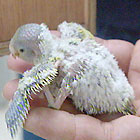The Australian budgerigar is the world’s most popular pet, and therefore the world’s most popular bird as well. Don highly recommends breeding budgies as a hobby, particularly for kids. As well as being very easy and great fun, it teaches them about basic animal husbandry and introduces them to applied science. And there’s nothing quite like the thrill of seeing your first baby bird coming out of the nest, sitting on a perch and saying hello!
When are budgies ready to breed?
Budgerigars have a coloured area above their beaks, called a cere. In males the cere is coloured light to dark blue. A male bird in breeding condition will have a deep blue cere in most varieties. He won’t have any pin feathers, and his plumage will be smooth. Females have brown ceres. Hens that are ready to lay eggs have fairly rough ceres that are a dark brown, chocolate colour. In fact, the darker they are the better. Don showed a hen with a whitish-brown cere, and explained that she was not ready to breed.
Cabinets are best
An aviary is not the best breeding environment for budgies because they tend to fight, much like humans in an overcrowded house. Don recommended putting your breeding pairs into cabinets. These are a bit like pigeon holes, with one pair to each cabinet. A nesting box is attached to the outside of each cabinet, usually with a hinged lid to allow the owner to check its contents. Cabinets are available from most bird shops, and they can be purchased separately or in rows.
Caring for the babies
Keeping and breeding budgerigars is very straightforward, but tremendously rewarding. Raising the chicks doesn’t take a great deal of skill, as the majority of budgerigars are excellent parents and they’ll do most of the work. Don opened a nest box and showed 5 or 6 babies, with a few eggs still to hatch. Budgies are tiny when they first hatch, but within about five weeks they are usually ready to leave the nest. Don feeds his budgies silverbeet, carrot, seed, shellgrit, water and a cuttlefish bone.
Costs
Budgie nesting boxes cost from $3-$6. Cabinets range in size from single ($30), double ($55), and triple ($75). Rows of four are not as widely available. Both nesting boxes and cabinets are cheaper if bought directly from a breeder rather than from a pet store. Breeders can be found in your local Yellow Pages under Bird Breeders &/or Dealers.
To find out more
Here are some good sources of information on keeping and breeding budgerigars:
Book
‘Budgerigars – All You Need to Know’ (1996) by Michael S. Christian. Published by McGraw Hill. ISBN 0074703616.
Video
‘Budgerigars for Beginners’ by John Scull. RRP $32.95. Available through Australian Birdkeeper, phone (07) 5590 7777.
The Budgerigar Information Line
Barry Ryan – phone (02) 9671 5380. Barry is happy to advise on budgerigar problems & societies (both local & interstate).



